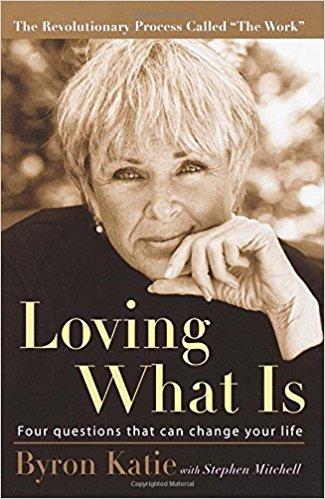Loving What Is Summary
5 min read ⌚
 Four Questions That Can Change Your Life
Four Questions That Can Change Your Life
Stress is everywhere. It always has been, it always will be. It is part of the human experience.
However, many times, we stress over imaginary situations, while having no real reason for unease.
In our summary of “Loving What Is” by Byron Katie, we will show you how you can pin down and analyze the exact thoughts that are stressing you, and ultimately reach inner peace.
Who Should Read “Loving What Is”? and Why?
Do you feel constantly stressed and unhappy? Are you concerned about the world’s problems: politics, pollution, famine?
Sadly, you are not the only one. Many people feel the same, and think there is no alternative to their unhappy ways of living.
However, there can be life with no anxiety, if you could just approach stress in the right way.
We recommend “Loving What Is” to all psychologists, people feeling stressed all the time, and people suffering from depression.
About Byron Katie
 Byron Katie is an author and speaker that based on her experience with depression, shares her methods of turning unhappiness upside down, with the purpose of helping people have better lives.
Byron Katie is an author and speaker that based on her experience with depression, shares her methods of turning unhappiness upside down, with the purpose of helping people have better lives.
“Loving What Is Summary”
Let’s say you are in a long-term, happy relationship.
At least, you thought it was happy until you started being suspicious that your partner does not love you anymore.
In this situation, your stress and unhappiness grow as you are looking for ways to push your partner into loving you again.
However, you cannot control other people’s feelings!
We told you this hypothetical story, so we can make you realize that stress is not caused by people around you, but by your very own interpretation of events or actions of those that surround you.
So, if we look at our story, it is not the lack of your partner’s love (which you are not even sure of) that causes pain. Instead, it is your interpretation of your partner’s feelings that make you unhappy.
Once you get that thought in your head: (s)he does not love me anymore, you will connect all his or her actions to your preconceived conclusion.
So, when they forget to kiss you, you think they do not love you. If they are tired and want to sleep, you assume they do not care. And so on, and so on.
Basically, everything they do will be reinforcing your opinion. It is a circle with no end.
So, what can you do to overcome this situation?
Well, as we already showed you, stress is directly related to your thoughts, so the only possible way to change something is to change your beliefs.
This is the place where “The Work” comes in.
The Work is a few step process that will help you find the roots of your problems.
You start the process by writing down the thoughts that are causing stress.
Then, analyze what you wrote by posing the following simple questions:
-
- Is this thought true?
-
- Can I be absolutely sure of its truth?
-
- How does this thought make you react?
- Without this thought, who would you be?
How you answer these questions will give you a more in-depth comprehension of your unproductive thoughts, which are only bringing stress into your life.
Once you do, you can begin trying to make yourself feel better.
The next and last step of The Work is the turnaround.
You can guess its meaning by its name. This step is all about turning your thoughts around to discover greater truths about the situation, your feelings, and eventually – yourself.
So, if like in our hypothetical situation your thoughts revolve around a belief that your partner no longer loves you, turn those thoughts around and observe what happens.
In other words, approach the problem from a different angle and see how all those various scenarios make you feel.
After doing that, analyze the turned though with the same four questions from The Work.
Doing this will make you aware of the difference between your original and turned thoughts and will give you new insight into your dilemma.
Okay, we told you the process, but you still do not know which thought you should follow at the end?
Well, that is up to you.
The Work only gives you options so that you can assess the problem more objectively; it does not give you an easy way out.
Growth must be accompanied by hard work. It is up to you to do it.
Key Lessons from “Loving What Is”
1. Write Down Your Thoughts
2. Finding Happiness
3. Using the Work In All Areas Of Life
Write down your thoughts
Do not do The Work in your mind. Our thoughts are too chaotic, and you cannot completely comprehend them if you do not write them down.
So take a pen and paper and thoroughly study your mind.
Finding Happiness
Contrary to what many people think, happiness does not depend on the reality. Many times you will be unable to change the circumstances. We are powerless against wars, pollution, hunger, and many other global problems. Sometimes we are even powerless against many personal issues.
So happiness is all about finding your peace when you are in reality you cannot change.
Then again, we are not saying that you should just sit and not do anything. We just want to make you happy for each small change you can make happen, and stop worrying about things you cannot control.
Using The Work In All Areas Of Life
The work can help you have better relationships, better career, better friendships.
How?
Well, when you apply it to any aspect of your life, you will most probably realize that you have been stressed over for nothing.
Many times we cannot see the thoughts that trouble as. And even more often, all the stress blinds us to the fact that our thoughts are the ones who are causing our unease.
Like this summary? We’d Like to invite you to download our free 12 min app, for more amazing summaries and audiobooks.
“Loving What Is” Quotes
As long as you think that the cause of your problem is “out there”—as long as you think that anyone or anything is responsible for your suffering—the situation is hopeless. It means that you are forever in the role of victim, that you’re… Share on X A thought is harmless unless we believe it. It’s not our thoughts, but our attachment to our thoughts, that causes suffering. Attaching to a thought means believing that it’s true, without inquiring. A belief is a thought that we’ve been… Share on X I am a lover of what is, not because I'm a spiritual person, but because it hurts when I argue with reality. Share on X Peace doesn't require two people; it requires only one. It has to be you. The problem begins and ends there. Share on X You move totally away from reality when you believe that there is a legitimate reason to suffer. Share on XOur Critical Review
“Loving What Is” gives you practical and applicable methods for tackling stress. If you put in enough work, you will create a happier and more fulfilled life for yourself.
Emir is the Head of Marketing at 12min. In his spare time, he loves to meditate and play soccer.


 Four Questions That Can Change Your Life
Four Questions That Can Change Your Life




